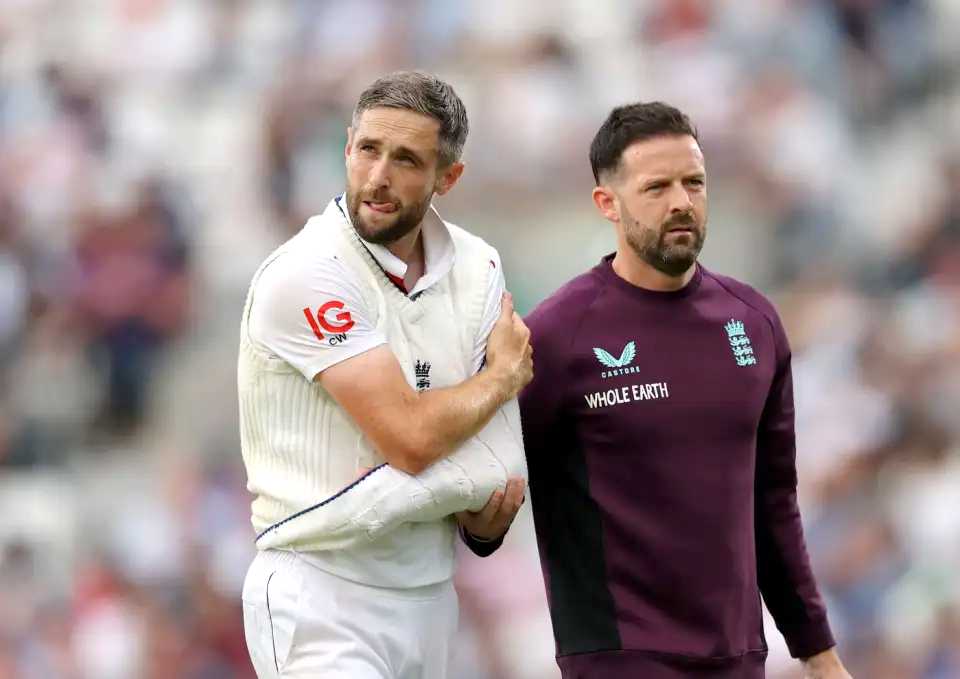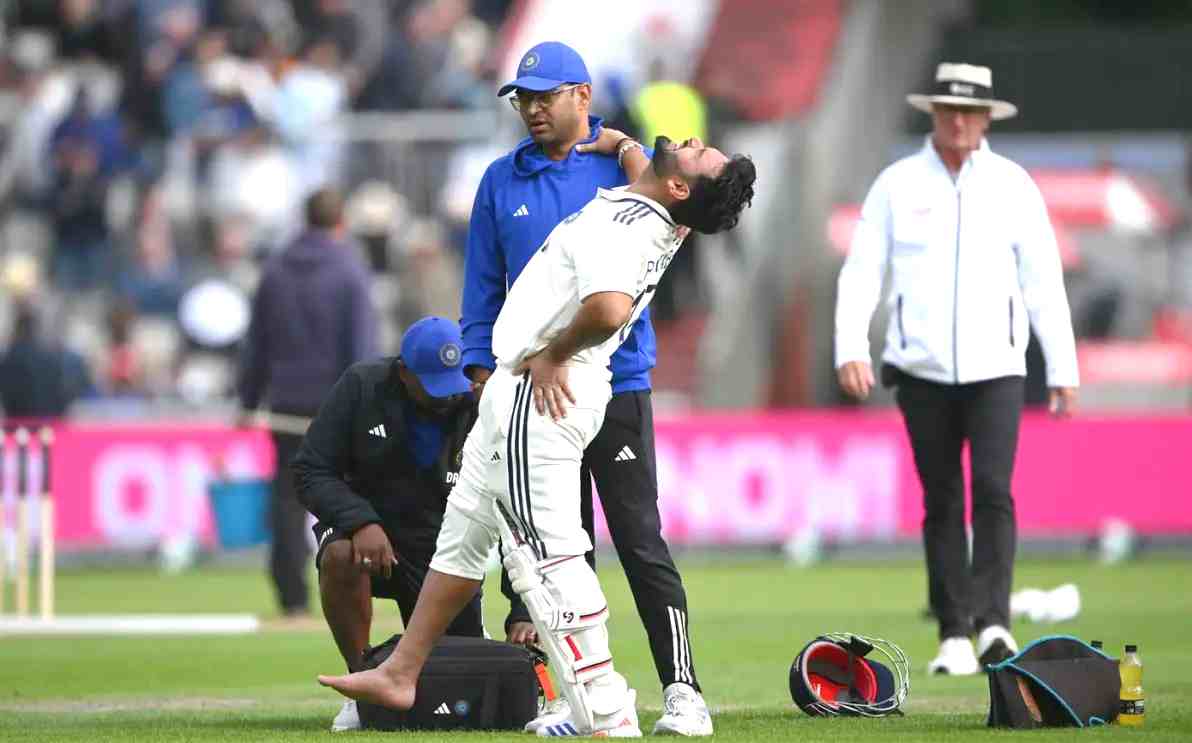ENG vs IND 2025: With Rishabh Pant’s toe fracture and Woakes’ shoulder injury, Is it time for ICC to allow full injury substitutes in Tests?

There was a great atmosphere at Old Trafford last week when Rishabh Pant hobbled down the stairs to bat with a broken foot on the second morning. The entire Manchester clapped for his bravery. But it just showed that even in the modern generation, Test cricket is still stuck in the dark ages. It’s the only team sport that doesn’t allow injury substitutes to balance the contest between a full-strength side and a team effectively playing with 10 men for four days.
Pant got injured while trying to reverse sweep Chris Woakes, who now has faced the same issue this week at the Kennington Oval. Woakes chased the ball from mid-off to the boundary rope towards the end of the first evening session. But his left hand appeared to slip on the damp outfield.
This resulted in the veteran landing awkwardly on the left shoulder before the physio rushed him for some treatment. The pain in his eyes was clear, indicating that he might have dislocated his shoulder. Later, he used the jumper as a makeshift on his way back to the dressing room. The England Cricket Board (ECB), on the second morning, revealed that the seaming all-rounder will not take any further part in the game, which pushes the hosts to play with 10 players for four days.
Read More: ENG vs IND 2025, 5th Test, Day 2: India 52 runs ahead after 15-wicket day at The Oval
Injury substitutes- a necessity in Test cricket to hold balance
It’s hard to fathom the injury substitute rule for the non-cricket lovers. Many couldn’t get their heads around the fact that Pant was allowed to have a replacement as wicketkeeper, but not to bat. It’s really inconsistent. Pant had been the X-factor for the blue brigade for the last several years in the longest format. Moreover, he was in excellent form in the series.
The situation for England is actually worse than India’s, given that they lost their most experienced member of the bowling attack. The solution is very simple: once a player suffers a new injury, they can be replaced by a like-for-like substitute. Those injuries can easily be proven by doctors and scans. But they will have to be clear and obvious ones, like Woakes and Pant went through.
India’s head coach, Gautam Gambhir, batted for the idea as he felt, “If the umpires and the match referee see and feel that it’s a major injury, I think it’s very important.” He also stressed, “There’s nothing wrong in doing that, especially in a series like this where it’s been such a closely fought series in the previous three Test matches.”
There were many instances in the past where teams would not have suffered in the 10 vs 11 men contest. Pakistan’s opener, Saim Ayub, twisted his ankle in the first hour of the Cape Town Test earlier this year. He couldn’t take part in the contest, as was the case with Nathan Lyon, who tore his calf at Lord’s in 2023. James Anderson also did his calf in the first morning session of the 2019 Edgbaston Test.
The ICC has already brought the concussion substitute, which is vital in any format of the game. But it feels bizarre that it’s the only way to get a sub. Any player getting hit on the head means he lacks the skill of facing the short ball. However, despite that, the player can get a replacement.
Ben Stokes, England’s captain, addressed the idea as ridiculous. But Ben perhaps got the point the wrong way. He said, “there would just be too many loopholes for teams to be able to go through. You pick your XI for a game; injuries are part of the game.”
Stokes reckoned that an MRI scan would always show an injury in a pacer. But the entire debate is around the injury that the individual has picked up in that very game before everyone’s eyes.
Read More: Management professional Sanjog Gupta appointed ICC CEO: Know more about hi

ICC needs to be careful to avoid loopholes in playing conditions of injury substitutes
In case the ICC allows the injury substitute rule in the future, they have to be really careful with the laws. Otherwise, the players would use it as their advantage. The first and foremost will be around the type of injuries. There will be instances when a batter would get hit on the arm, and he won’t be able to hold the bat. It’s uncomfortable, but in the end, it’s only a bruise. The debate isn’t around these kinds of injuries.
We’ve asked it before, we’ll ask it again:
— Test Match Special (@bbctms) July 31, 2025
🤔 Should injury substitutions in Test cricket be introduced?
#BBCCricket | @MichaelVaughan pic.twitter.com/CXxHnJ9K9b
They will also have to be careful with the replacements. The biggest issue will be around the touring parties. For example, a left-arm spinner pulls up a hammy, and the rule will allow him to get swapped. But, unfortunately, the visitors don’t have another left-arm spinner in the squad. So, their hands will be tied behind their backs to bring the available leg spinner into the team, and suddenly, it will be a different game.
The bottom line is very simple. Injury substitutions are a huge necessity in the game. Woakes and Pant’s injuries have shown that the format is still in the dark ages, but the ICC has to be really careful in making the rules. Anywhere they leave a gap, the players will work with that and try to use it to their advantage.
There should not be injury substitutes in test cricket. The game is played over 5 days for a reason. (Some) teams bat long in order to wear a bowling unit down. If you could substitute a fresh bowler in because of injury it would just be wrong.
— Steven Finn (@finnysteve) July 24, 2025
Also, how on earth do you…
A beautifully balanced series thrown out of kilter by an outdate rule. @testcricket should allow substitutes in my opinion. It focuses on what I have been saying about injuries. They happen too frequently & far, far too frequently if you can't replace an injured player.…
— Richard Ingham Evans (@Ringham7) August 1, 2025

